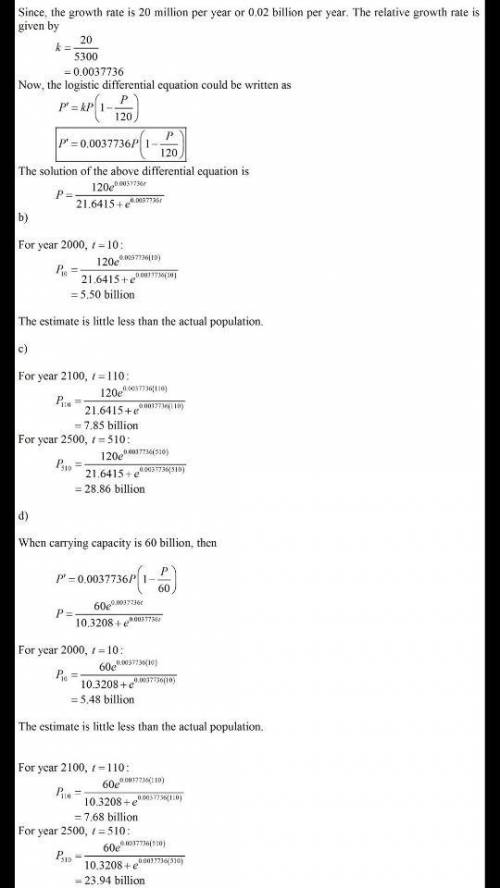
Mathematics, 06.05.2020 08:23 babyboo6745
He population of the world was about 5.3 billion in 1990. Birth rates in the 1990s ranged from 35 to 40 million per year and death rates ranged from 15 to 20 million per year. Let's assume that the carrying capacity for world population is 100 billion. (Assume that the difference in birth and death rates is 20 million/year
(a) Write the logistic differential equation for these data. (Because the initial population is small compared to the carrying capacity, you can take k to be an estimate of the initial relative growth rate. Let P be the population in billions and t be the time in years, where
t = 0
corresponds to 1990.)
dP/dt =
year 2100 P =
year 2500 P =
=
(b) Use the logistic model to estimate the world population in the year 2000. Compare with the actual population of 6.1 billion. (Round the answer to two decimal places.)
P =
(c) Use the logistic model to predict the world population in the years 2100 and 2500. (Round your answer to two decimal places.)
(d) What are your predictions if the carrying capacity is 60 billion? (Round your answers to two decimal places.)
year 2000 P =
year 2100 P =
year 2500 P =

Answers: 1
Another question on Mathematics

Mathematics, 21.06.2019 22:00
Thanh and her crew are building a stage in the shape of a trapezoid for an upcoming festival. the lengths of the parallel sides of the trapezoid are 14 ft and 24 ft. the height of the trapezoid is 12 ft.what is the area of the stage? enter your answer in the box. ft²
Answers: 2

Mathematics, 21.06.2019 23:00
Which statement accurately explains whether a reflection over the y axis and a 270° counterclockwise rotation would map figure acb onto itself?
Answers: 1

Mathematics, 22.06.2019 01:00
The triangles are similar. what is the value of x? enter your answer in the box.
Answers: 1

Mathematics, 22.06.2019 01:00
For every corresponding pair of cross sections, the area of the cross section of a sphere with radius r is equal to the area of the cross section of a cylinder with radius and height 2r minus the volume of two cones, each with a radius and height of r. a cross section of the sphere is and a cross section of the cylinder minus the cones, taken parallel to the base of cylinder, is the volume of the cylinder with radius r and height 2r is and the volume of each cone with radius r and height r is 1/3 pie r^3. so the volume of the cylinder minus the two cones is therefore, the volume of the cylinder is 4/3pie r^3 by cavalieri's principle. (fill in options are: r/2- r- 2r- an annulus- a circle -1/3pier^3- 2/3pier^3- 4/3pier^3- 5/3pier^3- 2pier^3- 4pier^3)
Answers: 3
You know the right answer?
He population of the world was about 5.3 billion in 1990. Birth rates in the 1990s ranged from 35 to...
Questions


Geography, 27.07.2019 15:10

Mathematics, 27.07.2019 15:10

Chemistry, 27.07.2019 15:10

Biology, 27.07.2019 15:10

Biology, 27.07.2019 15:10

Biology, 27.07.2019 15:10

Mathematics, 27.07.2019 15:10

Physics, 27.07.2019 15:10

English, 27.07.2019 15:10

Physics, 27.07.2019 15:10

Biology, 27.07.2019 15:10

Mathematics, 27.07.2019 15:10





Mathematics, 27.07.2019 15:10


Chemistry, 27.07.2019 15:10




